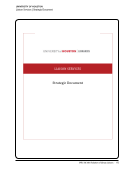38 · Survey Results: Survey Questions and Responses
The majority of the librarians are subject specialists or liaisons. Those who have this responsibility are typically hired with
some set of skills or requirements that match the needs of that department/school/discipline, etc. However, we have
many librarians who have no formal background in the areas they serve. For example, we have social scientists who
serve science disciplines.
They are all subject/reference librarians.
They are hired as liaisons (or subject specialists), or they had the liaison function in their job prior to the establishment of
the Academic Liaison Program reorganization.
They are hired into a liaison role as the subject librarian or curator. Other librarians are hired as technical services
librarians or functional specialists. Upon the retirement of a subject librarian, subject areas may get reassigned to other
subject librarians, area studies librarians, or curators or we may re-hire in those same subjects.
They are in outward-facing research support roles or have language proficiency that correlates with an area of study.
Most liaisons are in the User Services division a few are in the Technical Services division (which includes Collections &
Licensing as well as Cataloging &Metadata Services).
They are selected based on their association with academic departments, which is informed by either their bibliographer
responsibilities or reference/information services responsibilities.
Those librarians that serve a subject discipline are liaisons. They may be a liaison to a department or a college.
Those with a workplan of greater than 50% designated to support clinical services have the title clinical services
librarian. All reference librarians must do some clinical services but their level of effort is less than 50%. Librarians in
collections, historical archives, and administration may not have any clinical services responsibilities.
Usually those with subject expertise.
We have specific liaison librarian positions that librarians are hired into. We have other librarian positions such as
cataloguers or the digital repository librarian, which don’t have liaison responsibilities.
We hire and appoint for specific subject areas. Each vacant position is reviewed by the library faculty and relevant
administrators for continuation or adjustment.
We may start using a professional as well who has an MLS.
Answered “All Librarians” N=5
All members of the information services/collections departments at each campus site serve as liaisons. There is also one
professional in another department who serves as a liaison, and the plan in the coming year is to incorporate at least
one more person outside the department.
All reference librarians and bibliographers have liaison duties.
Liaisons are only in the department formerly known as Reference.
Most of our subject librarians are considered professional librarians (MLIS or PHD in subject area) a few with language
specialty are liaisons without above.
We hire directly for liaison positions liaison duties are included in their job descriptions.
The majority of the librarians are subject specialists or liaisons. Those who have this responsibility are typically hired with
some set of skills or requirements that match the needs of that department/school/discipline, etc. However, we have
many librarians who have no formal background in the areas they serve. For example, we have social scientists who
serve science disciplines.
They are all subject/reference librarians.
They are hired as liaisons (or subject specialists), or they had the liaison function in their job prior to the establishment of
the Academic Liaison Program reorganization.
They are hired into a liaison role as the subject librarian or curator. Other librarians are hired as technical services
librarians or functional specialists. Upon the retirement of a subject librarian, subject areas may get reassigned to other
subject librarians, area studies librarians, or curators or we may re-hire in those same subjects.
They are in outward-facing research support roles or have language proficiency that correlates with an area of study.
Most liaisons are in the User Services division a few are in the Technical Services division (which includes Collections &
Licensing as well as Cataloging &Metadata Services).
They are selected based on their association with academic departments, which is informed by either their bibliographer
responsibilities or reference/information services responsibilities.
Those librarians that serve a subject discipline are liaisons. They may be a liaison to a department or a college.
Those with a workplan of greater than 50% designated to support clinical services have the title clinical services
librarian. All reference librarians must do some clinical services but their level of effort is less than 50%. Librarians in
collections, historical archives, and administration may not have any clinical services responsibilities.
Usually those with subject expertise.
We have specific liaison librarian positions that librarians are hired into. We have other librarian positions such as
cataloguers or the digital repository librarian, which don’t have liaison responsibilities.
We hire and appoint for specific subject areas. Each vacant position is reviewed by the library faculty and relevant
administrators for continuation or adjustment.
We may start using a professional as well who has an MLS.
Answered “All Librarians” N=5
All members of the information services/collections departments at each campus site serve as liaisons. There is also one
professional in another department who serves as a liaison, and the plan in the coming year is to incorporate at least
one more person outside the department.
All reference librarians and bibliographers have liaison duties.
Liaisons are only in the department formerly known as Reference.
Most of our subject librarians are considered professional librarians (MLIS or PHD in subject area) a few with language
specialty are liaisons without above.
We hire directly for liaison positions liaison duties are included in their job descriptions.












































































































































































































